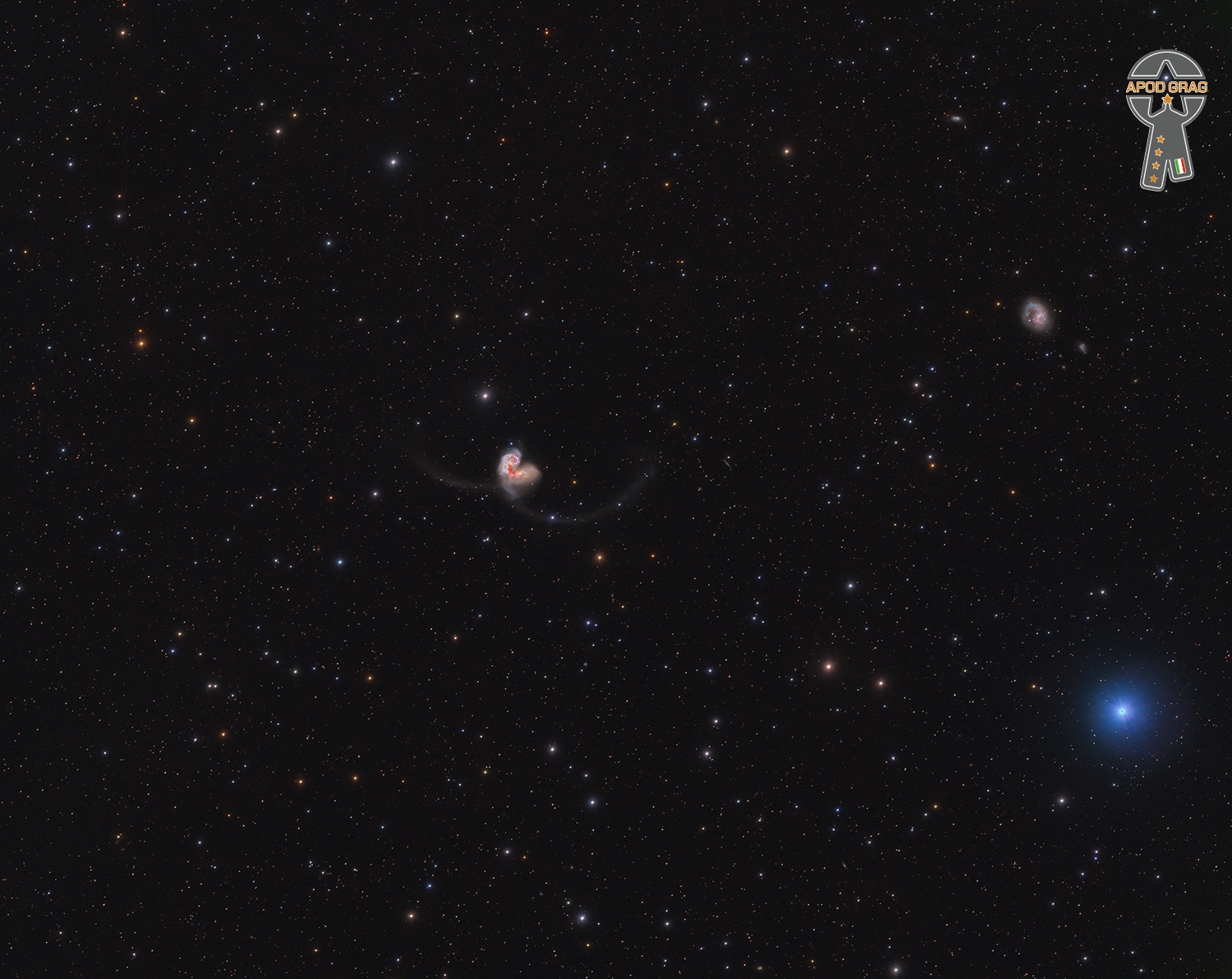Blog
A white dwarf star begins its life by casting off a cocoon of gas that enclosed its former self. In this analogy, however, the Sun would be a caterpillar and the ejected shell of gas would become the prettiest cocoon of all. In the featured cocoon, the planetary nebula designated NGC 2440 contains one of the hottest white dwarf stars known. The white dwarf can be seen as the bright orange dot near the image center. Our Sun will eventually become a white dwarf butterfly, but not for another 5 billion years.

David Louis Bartholomew (December 24, 1918 – June 23, 2019) was an American musician, bandleader, composer, arranger, and record producer. He was prominent in the music of New Orleans throughout the second half of the 20th century. Originally a trumpeter, he was active in many musical genres, including rhythm and blues, big band, swing music, rock and roll, New Orleans jazz, and Dixieland. In his induction into the Rock and Roll Hall of Fame, he was cited as a key figure in the transition from jump blues and swing to R&B and as “one of the Crescent City’s greatest musicians and a true pioneer in the rock and roll revolution”.
Many musicians have recorded Bartholomew’s songs, but his partnership with Fats Domino produced some of his greatest successes. In the mid-1950s they wrote more than forty hits for Imperial Records, including the Billboard number one pop chart hit “Ain’t That a Shame“. Bartholomew’s other hit songs as a composer include “I Hear You Knocking“, “Blue Monday“, “I’m Walkin’“, “My Ding-a-Ling“, and “One Night“. He was a member of the Songwriters Hall of Fame, the Rock and Roll Hall of Fame, and the Louisiana Music Hall of Fame.
more...Woody Herman Shaw Jr. (December 24, 1944 – May 10, 1989) was an American jazz trumpeter, flugelhornist, cornetist, composer, arranger, band leader, and educator. Shaw is widely known as one of the most important and influential jazz trumpeters and composers of the twentieth century. He is often credited with revolutionizing the technical and harmonic language of modern jazz trumpet playing, and to this day is regarded by many as one of the major innovators of the instrument. He was an acclaimed virtuoso, mentor, and spokesperson for jazz and worked and recorded alongside many of the leading musicians of his time. Woody Shaw was born in Laurinburg, North Carolina, United States. He was taken to Newark, New Jersey, by his parents, Rosalie Pegues and Woody Shaw Sr., when he was one year old. Shaw’s father was a member of the African American gospel group known as the “Diamond Jubilee Singers” and both his parents attended the same secondary private school as Dizzy Gillespie: Laurinburg Institute. Shaw’s mother was from the same town as Gillespie: Cheraw, South Carolina.
more...Raphael Homer “Ray” Bryant (December 24, 1931 – June 2, 2011) was an American jazz pianist, composer, and arranger.
Bryant was born in Philadelphia, Pennsylvania, on December 24, 1931. His mother was an ordained minister who had taught herself to play the piano; his father also played the piano and sang. His brothers were the bass player Tommy, drummer and singer Len, and Lynwood. Ray began playing the piano around the age of six or seven, following the example of his mother and his sister, Vera. Gospel influences in his playing came from being part of the church at this stage in his early life. He had switched from classical music to jazz by his early teens and played the double bass at junior high school. He was first paid to play when he was 12: “I would play for dances, and they’d sneak me into bars. I’d get four or five bucks a night, which was good money then.” He turned professional aged 14, and immediately joined a local band led by Mickey Collins.
more...Warren “Baby” Dodds (December 24, 1898 – February 14, 1959) was an American jazz drummer born in New Orleans, Louisiana. He is regarded as one of the best jazz drummers of the pre-big band era. He varied his drum patterns with accents and flourishes, and he generally kept the beat with the bass drum while playing buzz rolls on the snare. Early influences included Louis Cottrell, Sr., Dave Perkins, and Tubby Hall. Dodds was among the first drummers to be recorded improvising while performing.
“Baby” Dodds was the younger brother of clarinetist Johnny Dodds. His mother, who died when he was nine years old, taught him valuable lessons about persistence and putting one’s whole effort into endeavors, and he carried these with him through his career as a jazz drummer. He was born into a very musical family. His father and uncle played violin and his sister played harmonica. In addition, his father was religious and the family regularly sang hymns together. Dodds, in his autobiography The Baby Dodds Story, told the story of making his first drum: “I took a lard can and put holes in the bottom and turned it over and took nails and put holes around the top of it. Then I took some rungs out of my mother’s chairs and made drumsticks out of them”. At age 16, Dodds saved up enough money to buy his own drum set. Although Dodds had several paid teachers during his early years as a drummer, various jazz drummers around New Orleans also influenced him. He started playing in street parades around New Orleans with Bunk Johnson and his band and then gained a job playing in Willie Hightower’s band, the American Stars. The band played in various venues around New Orleans, and Dodds recalled hearing many musicians along the way, including Buddy Bolden, John Robichaux, and Jelly Roll Morton. He played with several different outfits including those of Frankie Duson and Sonny Celestin, and he was part of the New Orleans tradition of playing jazz during funeral marches. Dodds describes this experience in his autobiography: “The jazz played after New Orleans funerals didn’t show any lack of respect for the person being buried. It rather showed their people that we wanted them to be happy”.
more...The supernova, named Requiem, is embedded in the giant galaxy cluster MACS J0138. The cluster is so massive that its powerful gravity bends and magnifies the light from the supernova, located in a galaxy far behind it. Called gravitational lensing, this phenomenon also splits the supernova’s light into multiple mirror images, highlighted by the white circles in the 2016 image. The multiply imaged supernova disappears in the 2019 image of the same cluster, at right. The snapshot, taken in 2019, helped astronomers confirm the object’s pedigree. Supernovae explode and fade away over time. Researchers predict that a rerun of the same supernova will make an appearance in 2037. The predicted location of that fourth image is highlighted by the yellow circle at top left. The light from Supernova Requiem needed an estimated 10 billion years for its journey, based on the distance of its host galaxy. The light that Hubble captured from the cluster, MACS J0138.0-2155, took about four billion years to reach Earth. The images were taken in near-infrared light by Hubble’s Wide Field Camera 3.

Esther Phillips (born Esther Mae Jones; December 23, 1935 – August 7, 1984) was an American singer, best known for her R&B vocals. She rose to prominence in 1950, scoring several major R&B hits including “Double Crossing Blues” and “Mistrustin’ Blues” under the moniker “Little Esther”. In the 1960s, she achieved chart success with the country song “Release Me” and recorded in the pop, jazz, blues and soul genres. Phillips received a Grammy nomination for her single “Home Is Where the Hatred Is” in 1973 and her disco recording of “What a Diff’rence a Day Makes” was a major hit in 1975. She died from liver and kidney failure due to long-term drug abuse in 1984.
Phillips was born Esther Mae Jones in Galveston, Texas, U.S. Her parents divorced during her adolescence, and she divided her time between her father, in Houston, and her mother, in the Wattssection of Los Angeles. She was brought up singing in church and was reluctant to enter a talent contest at a local blues club, but her sister insisted. A mature singer at the age of 14, she won the amateur talent contest in 1949 at the Barrelhouse Club, owned by Johnny Otis. Otis was so impressed that he recorded her for Modern Records and added her to his traveling revue, the California Rhythm and Blues Caravan, billed as Little Esther. She later took the surname Phillips as her stage name, reportedly inspired by a sign at a gas station.
more...Frank Morgan (December 23, 1933 – December 14, 2007) was a jazz saxophonist with a career spanning more than 50 years. He mainly played alto saxophone but also played soprano saxophone. He was known as a Charlie Parker successor who primarily played bebop and ballads.
Frank Morgan was born in Minneapolis, Minnesota in 1933, but spent most of his childhood living with his grandmother in Milwaukee, Wisconsin while his parents were on tour. Morgan’s father Stanley was a guitarist with Harlan Leonard and the Rockets and The Ink Spots, and his mother, Geraldine, was a 14-year-old student when she gave birth to him. Morgan took up his father’s instrument at an early age, but lost interest the moment he saw Charlie Parker take his first solo with the Jay McShann band at the Paradise Theater in Detroit, Michigan. Stanley introduced them backstage, where Parker offered Morgan advice about starting out on the alto sax, and they met at a music store the following day. Morgan, seven years old at the time, assumed they’d be picking out a saxophone, but Parker suggested he start on the clarinet to develop his embouchure. Morgan practiced on the clarinet for about two years before acquiring a soprano sax, and finally, an alto. Morgan moved to live with his father (by that time divorced) in Los Angeles, California at the age of 14, after his grandmother caught him with marijuana.
more...Chesney Henry “Chet” Baker Jr. (December 23, 1929 – May 13, 1988) was an American jazz trumpeter and vocalist. He is known for major innovations in cool jazz that led him to be nicknamed the “Prince of Cool”.
Baker earned much attention and critical praise through the 1950s, particularly for albums featuring his vocals: Chet Baker Sings (1954) and It Could Happen to You (1958). Jazz historian Dave Gelly described the promise of Baker’s early career as “James Dean, Sinatra, and Bix, rolled into one”. His well-publicized drug habit also drove his notoriety and fame. Baker was in and out of jail frequently before enjoying a career resurgence in the late 1970s and 1980s.
Baker was born December 23, 1929, in Yale, Oklahoma, and raised in a musical household. His father, Chesney Baker Sr., was a professional Western swing guitarist, and his mother, Vera Moser, was a pianist who worked in a perfume factory. His maternal grandmother was Norwegian. Baker said that owing to the Great Depression, his father, though talented, had to quit as a musician and take a regular job. In 1940, when Baker was 10, his family relocated to Glendale, California.
more...https://youtu.be/-z5V-a-urgQ?si=qeP4_VdAXETyKEhy
more...Mt Zion Shabbat for the Soul Friday service with Tami Morse, mick labriola with Guitar Corp and violin.
more...The antennae galaxies which is the collision between the galaxies NGC 4038 and NGC 4037, next to it the small ESO 572-45
In the upper right corner: The galaxy NGC 4027, just below it a smaller one called ESO 572-36 and above it another, even smaller one, called ESO 572-34
Several other small galaxies can be seen in the field, best seen in the high definition image, you can travel in the field looking for small galaxies.
The NGC 4038 Group is a group of galaxies in the constellations Corvus and Crater. The group may contain between 13 and 27 galaxies. The group’s best known galaxies are the Antennae Galaxies (NGC 4038/NGC4039), a well-known interacting pair of galaxies.

More Posts
- Stuff Smith Day
- World Music with Lingua Franca Ensemble
- Daily Roots with Bunny Wailer
- The Cosmos with NGC 2736
- Mulgrew Miller Day
- George Shearing Day
- World Music with Tabanka
- Daily Roots with Prodigal Creator
- The Cosmos with Meteor M31
- Pat Metheny Day
- Papa Joe Jones Day
- World Music with Elle Márjá Eira
- Daily Roots with Stranger Cole
- The Cosmos with NGC 6357
- Vikku Vinayakram Day
- Bruz Freeman Day
- World Music with the Bushmen & Himba
- Daily Roots with the Dynamics
- World Music with Francisco Tarrega
- The Cosmos with IC 4406



